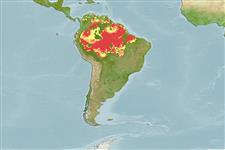Classification / Names
Common names from other countries
Main reference
Size / Weight / Age
Max length : 99.0 cm TL male/unsexed; (Ref. 40637); max. published weight: 12.2 kg (Ref. 40637)
Length at first maturity
Lm ?, range 31 - 36 cm
Environment
Freshwater; benthopelagic; pH range: 5.5 - 6.5
Climate / Range
Tropical; 27°C - 29°C (Ref. 13614), preferred ?
Distribution
Short description
Diagnosis: A large, elongate species with small scales (E1 row scales 98-128, usually more than 110, vs. usually less than 110 in other species of Cichla). Postorbital band is present, entire, may be irregular but does not consist of scattered spots, vs. absent or present as scattered spots in other species of Cichla species. Lateral line is usually continuous. It is most similar to C. pinima and C. vazzoleri, sharing subadult to young adult color pattern including dark midlateral band and four rows of regularly arranged light spots along side, but light spots slightly elongate instead of round. It is different from C. pinima and C. vazzoleri in lacking dark lateral blotches with intensified light margins; vertical bars when expressed entire, never forming round blotches; ocellated blotches on dorsal side absent at all sizes; postorbital band entire (vs. expressed as scattered dark blotches); dark blotch associated with preopercle absent (present in C. vazzoleri); lateral line nearly always continuous (vs. usually discontinuous in C. vazzoleri) (Ref. 57716).
IUCN Red List Status (Ref. 115185)
Threat to humans
Harmless
Human uses
Fisheries: commercial; aquaculture: commercial; gamefish: yes; aquarium: commercial
More information
ReferencesAquacultureAquaculture profileStrainsGeneticsAllele frequenciesHeritabilityDiseasesProcessingMass conversion
Tools
Special reports
Download XML
Internet sources
Estimates of some properties based on models
Phylogenetic diversity index
PD50 = 0.5000 many relatives (e.g. carps) 0.5 - 2.0 few relatives (e.g. lungfishes)
Trophic Level
4.5 ±0.5 se; Based on diet studies.
Resilience
Medium, minimum population doubling time 1.4 - 4.4 years (K=0.16)
Vulnerability
Moderate to high vulnerability (54 of 100)
Price category
